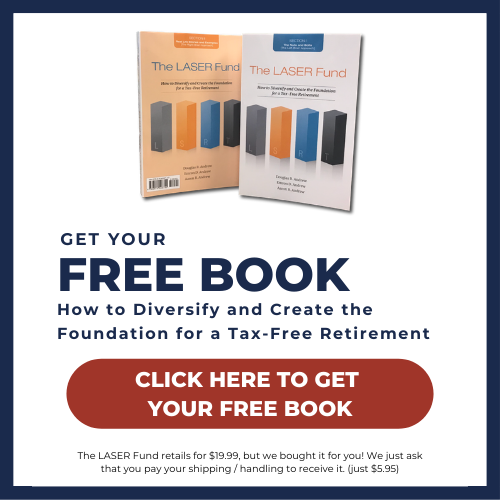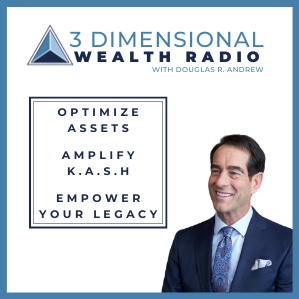I don’t own an IRA or a 401(k). Never have, never will. There’s something better, read on to find out what…and why.
Years ago, I wrote several editorial articles for newspapers and magazines, and one of the most-read was an article titled, “How Congress is Peddling IRA and 401(k) Snake Oil.”
The article addressed how Congress tries to dupe most Americans to contribute pre-tax dollars or tax-deductible contributions into IRAs and 401(k)s, accumulate the money tax-deferred, and then agree to pay tax when they withdraw the money during retirement.
THE WRONG PREMISE ABOUT YOUR TAXES
What was the original premise for that? The argument that you’ll likely be in a lower tax bracket when you retire. Well, folks, most Americans are not in lower tax brackets when they retire. That has not been true for decades now. And yet the financial services industry still touts that you ought to put money into a traditional IRA or 401(k), and that you’ll likely be in a lower bracket during retirement.
Now, the financial services industry actually has been forced to admit that most people who accumulate any type of a respectable retirement nest egg are not in lower brackets when they retire; in reality, they’re in as high or even higher brackets as they’ve ever been in—even if they have less income.
Why? Because most people go down the highway of life trying to save for retirement in these tax-deferred accounts, with one foot on the gas pedal and the other foot on the brake, without even realizing it.
The foot on the gas pedal would be the money in tax-deferred IRAs of 401(k)s. What’s the brake pedal? The typical sunsetting of the tax deductions you enjoyed during your earning and contribution years.
You see, during retirement, you’re likely no longer contributing to accounts like IRAs, 401(k)s, 403(b)s, or 457s. Your children are grown, so you’re no longer getting child tax deductions. If your house is paid off and you itemize on Schedule A, there go your mortgage interest deductions. You’re no longer working, so you’re no longer writing off business expenses. You’re experiencing what I call the Deduction Reduction.
Oh and don’t forget the other big retirement whopper—Congress has a habit of raising taxes.
For these reasons, most Americans hit retirement and find themselves in a tax bracket that’s as high or higher than during their earning years.
This phenomenon isn’t just experienced by the wealthy. Even folks like school teachers can feel the tax-deferred crunch. Once they reach retirement, within two-and-a-half years of taking distributions, teachers can end up paying back 100% of the taxes they saved over 30 years of making tax-deferred contributions. And they can do it again, and again, to where by the time they die, they have usually paid back 12 to 15 times the taxes they saved during their working years.
Who’s retirement were they planning? Theirs or Uncle Sam’s? They’re not alone; the vast majority of Americans get suckered into tax-deferred retirement accounts.
Some Americans understand that it’s better to bite the bullet and pay the tax at current rates (during their earning and contribution years). These are often the kind of people who choose a Roth IRA or 401(k). They realize they’re not going to be in a lower bracket when they retire, so they get taxes over and done with before putting their money into a retirement account.
THE DANGER OF HAVING YOUR MONEY AT RISK IN THE MARKET
As progressive as Roths are, I’m going to confess something else here. As mentioned previously, I’ve never owned a 401(k). I’ve also never owned a Roth IRA or either. Never have, never will. Why? Just like many other traditional retirement vehicles, they leave your money at risk in the market. While a Roth offers great tax benefits, it simply comes with too many strings attached.
To illustrate what I mean, let’s look at what happened during what I call the Lost Decade (2000- 2010). Between 2001 and 2003, millions of Americans lost 40% of their traditional retirement account values when the market declined after the 9/11 terrorist attacks. Then it happened all over again after the mortgage meltdown of 2008.
Let’s say you had a $1 million nest egg saved in IRAs and 401(k)s in the year 2001. In three years, you would have seen it go down to $600,000. Then it would have taken four years to come back to break-even at $1 million. During that same time period, many of our clients doubled their money using my favorite vehicle, the LASER Fund. How? They were protected by a 0% floor, which means they did not lose money due to market volatility when the market went down, and they made money when it was going up.
In 2008, you would have been like millions of Americans who lost 40% of their account values again when the market crashed. It would have taken another four years until 2012 to come back to break-even. That’s when most of our clients tripled their money.
WHY PEOPLE ARE SAYING IRAS AND 401(K)S AREN’T THE BEST
In 2009, Time Magazine featured a story, “Why It’s Time to Retire the 401(k).” The writer, Stephen Gandle, said, the 401(k) “is a lousy idea, a financial flop, a rotten repository for our retirement reserves.”
Well I’d have to agree–the vulnerability to market volatility is one of the reasons I’ve never owned an IRA or 401(k). Another is taxes. Taxes are likely going to be higher in the future, and we’re likely to be in a tax bracket that’s as high or higher than our earning years. So why postpone, defer, procrastinate paying taxes?
There’s another article that points out drawbacks to the 401(k). The Wall Street Journal article is titled, “The Champions of the 401(k) Lament the Revolution They Started.” The article explains that the 401(k) was meant to be a supplemental plan, but it ended up becoming the primary plan for most people in America. Why?
Employers and corporations wanted to be off the hook for things like defined benefit pensions, where they had to manage money and guarantee somebody a certain amount of income, like a school teacher or police officer, based on the years of service. For example, a pension plan might multiply the years of service by a percentage for guaranteed income during retirement (e.g., 30 years of teaching times 2% would equal 60% of the last best salary for the rest of the teacher’s life).
Employers have been increasingly dodging that kind of defined benefit pension. They are shifting instead to a defined contribution–like a 401(k)–where the employer lets you define how much you want to contribute from each paycheck, and they might match that contribution up to a certain percent. If your 401(k) makes or loses money in the market, that’s your problem. DALBAR says the average person who has money invested in the market in IRAs and 401(k)s is only earning 3.49%. How sad is that?
WHAT’S BETTER?
My favorite financial vehicle, a properly structured, maximum-funded Indexed Universal Life policy, knocks the socks off traditional and Roth IRAs and 401(k)s for several reasons:
- It eliminates the dangers of future higher taxes. With a LASER Fund, you get your taxes over and done with before contributing your money so you can enjoy tax-free income during retirement.
- It gives you the upsides of the market without the downsides. When the market goes down, you don’t lose. When the market goes up, you gain. How? By using a strategy called indexing, you can link your policy’s returns to the market while being protected by a 0% floor during downturns, rather than putting your money directly in the market as you would with traditional retirement vehicles.
- The LASER Fund allows you to contribute larger amounts, as opposed to the annual contribution limits of IRAs and 401(k)s.
- It also allows you to access money at any age, at any time, from your LASER Fund income-tax-free–and without any penalties (unlike the 10% early withdrawal penalty for IRAs and 401[k]s).
- The LASER Fund allows you to transfer the money in your policy to your heirs income-tax-free via the death benefit when you pass on.
To explore what a LASER Fund is and how it can make a difference in your financial future, I’ve got several resources for you.
WANT TO LEARN MORE?
Watch the Video – Watch the related YouTube video to see me explain “What’s Better than an IRA or 401(k) to Save for Retirement?” (and while you’re there, be sure to subscribe to my YouTube channel so you don’t miss a thing!).
Elevate Your Financial Dimension – Find out how you can improve your Financial Dimension journey and seize the liquidity, safety, predictable rates of return, and tax advantages of a LASER Fund. Explore the in-depth financial strategies and learn from real-life client experiences by claiming your free copy of “The LASER Fund” book at LASERFund.com. Just pay for shipping and handling, and we will send it to you, absolutely free.
Join a Webinar – Want to find out if a LASER Fund (a maximum-funded, properly structured indexed universal life insurance policy) is right for you? Join us for an upcoming webinar where you can explore these strategies


